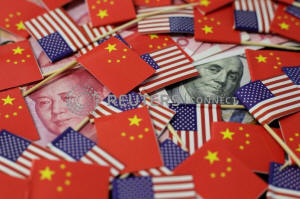|
But
it may morph into something bigger if U.S. President Donald
Trump agrees to Beijing's demands to roll back existing tariffs
on Chinese goods, people familiar with the talks say.
China's commerce ministry said this month that removing tariffs
imposed during the trade war is an important condition to any
deal. The demand has U.S. officials wondering if higher Chinese
purchases of U.S. farm goods, promises of improved access to
China's financial services industry, and pledges to protect
intellectual property are enough to ask in return.
Two people briefed on the talks said Trump has decided that
rolling back existing tariffs, in addition to canceling a
scheduled Dec. 15 imposition of tariffs on some $156 billion in
Chinese consumer goods, requires deeper concessions from China.
"The president wants the option of having a bigger deal with
China. Bigger than just the little deal" announced in October,
said Derek Scissors, a China scholar with the American
Enterprise Institute in Washington.
Scissors, who consults with administration officials, said
whether Trump will agree to remove existing tariffs depends
largely on whether he believes it will benefit his re-election
chances. Some White House advisers would like to see China agree
to large, specific agricultural purchases, while the U.S.
maintains existing tariffs for future leverage.
That would help Trump's farm belt constituency while allowing
the president to campaign on maintaining his "tough on China"
stance, which holds appeal to voters in key states like Ohio,
Michigan and Pennsylvania.
But Beijing is balking at committing https://www.reuters.com/article/us-usa-trade-china-agbuys/trumps-attempt-to-force-feed-china-u-s-farm-products-stymies-trade-talks-idUSKBN1X90BW
to a specific amount of farm product purchases, within a
particular time frame, and wants to let supply and demand
dictate deals instead.
Beijing also wants Trump to eliminate the 15% tariffs on about
$125 billion worth of Chinese goods imposed on Sept. 1, as well
as provide some relief from the 25% tariffs imposed on an
earlier, $250 billion list of industrial and consumer goods.
One Washington-based trade expert said that to achieve the
$40-50 billion in annual Chinese purchases of American farm
goods touted by Trump in October, he would likely have to
eliminate all of the tariffs the U.S. put in place since the
trade war started in 2018.
Trump and U.S. Trade Representative Robert Lighthizer recognize
that making such concessions for a "skinny" trade deal that
fails to address core intellectual property and technology
transfer issues is not a very good deal for Trump, a second
person briefed on last weekend's trade phone call said.
Trump is the final decision-maker in the U.S. on any deal, and
hasn't committed to any specifics so far, White House advisers
say.
The president said Tuesday that China "is going to have to make
a deal that I like. If they don't, that's it."
A 'phase one' trade deal, once expected to be completed within
weeks of an October news conference between Trump and Chinese
vice premier Liu He, could now be pushed into next year, trade
experts say.
(Additional reporting and editing by Heather Timmons; Editing by
Kim Coghill)
[© 2019 Thomson Reuters. All rights
reserved.] Copyright 2019 Reuters. All rights reserved. This material may not be published,
broadcast, rewritten or redistributed.
Thompson Reuters is solely responsible for this content.

|
|






